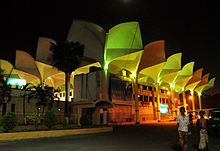See also: Transport in Bangladesh
Cycle rickshaws and auto rickshaws are the main mode of transport, with close to 400,000 rickshaws running each day – the largest number for any city in the world.[47][49] However, only about 85,000 rickshaws are licensed by the city government.[48][79] Relatively low-cost and non-polluting cycle rickshaws nevertheless cause traffic congestion and have been banned from many parts of the city. Public buses are operated by the state-run Bangladesh Road Transport Corporation (BRTC) and by private companies and operators. Scooters, taxis and privately owned automobiles are increasingly becoming popular with the city's growing middle class. The government has overseen the replacement of two-stroke engine taxis with "Green taxis" locally called CNG, which run on compressed natural gas.[80]
Dhaka has 1,868 kilometres (1,161 mi) of paved roads.[81] It is connected to the other parts of the country through strong highway and railway links. Highway links to the Indian cities of Kolkata andAgartala have been established by the BRTC which also runs regular bus services to those cities from Dhaka.[82]
The Kamalapur Railway Station, Airport (Biman Bandar) Railway Station and the Cantonment Railway Station are the main railway stationsproviding trains on suburban & national routes operated by the state-run Bangladesh Railway.[83] Bangladesh Railway also runs a regular train service between Dhaka and Kolkata.
The Sadarghat Port on the banks of the Buriganga River serves for the transport of goods and passengers upriver and to other ports in Bangladesh.[84]
The Shahjalal International Airport, located 15 km north of Dhaka city centre, is the largest and busiest airport in the nation.[85] It handles 52% of the country's international and domestic arrivals and departures. Domestic service flies to Chittagong, Sylhet, Cox's Bazar, Jessore, Barisal, Saidpur and international services fly to major cities in Asia, the Middle East, North Africa and Western Europe.
An elevated Expressway system is under construction.[86] The Dhaka Elevated Expressway would run from Shahjalal International Airport-Kuril-Banani-Mohakhali-Tejgaon-Saatrasta-Moghbazar rail crossing-Khilgaon-Kamalapur-Golapbagh to Dhaka-Chittagong highway at Kutubkhali point. A longer second elevated expressway from airport-Ashulia is currently undergoing feasibility study.[87]
The Dhaka Metro feasibility study has been completed. A 21.5 kilometer, $1.7 Billion Phase 1, metro route is being negotiated by the Government with Japan International Cooperation Agency. The first route will start from Pallabi, northern suburb of Dhaka to Sayedabad, southern section of Dhaka.[88]

